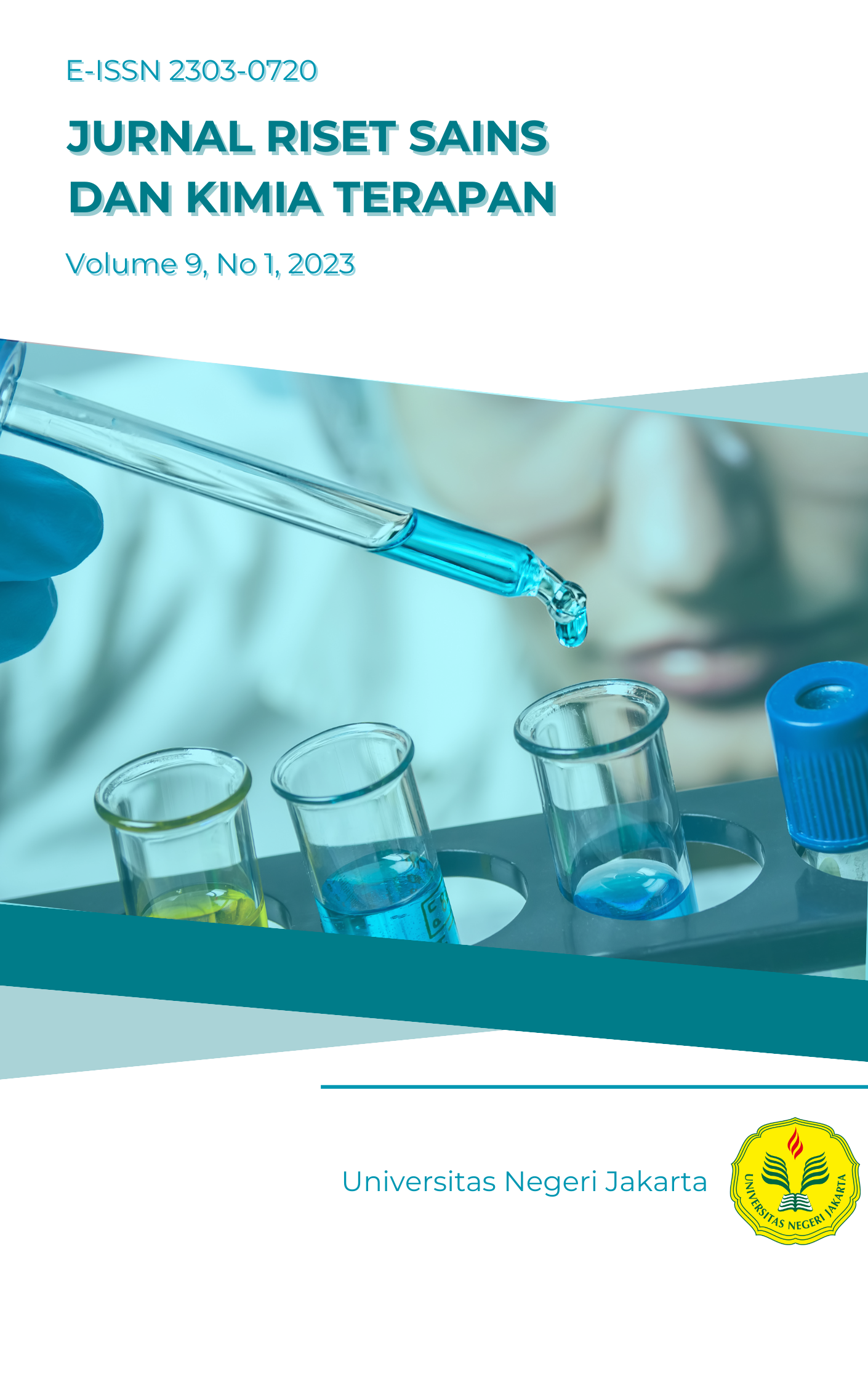Penentuan Kadar Formaldehida pada Baju Bayi dengan Metode Ekstraksi Air menggunakan Spektrofotometri Uv-Vis Sesuai SNI ISO 14184-1:2015
DOI:
https://doi.org/10.21009/JRSKT.101.01Keywords:
formaldehida, pakaian bayi, spektrofotometri UV-VisAbstract
Abstrak
Pakaian bayi, yang bersentuhan langsung dengan kulit, digunakan untuk bayi dari kelahiran hingga usia 36 bulan, merupakan salah satu faktor yang dapat menimbulkan risiko penyakit seperti iritasi kulit atau ruam pada kulit akibat bahan pakaian tersebut. Salah satu bahan kimia berbahaya yang terdapat dalam pakaian bayi adalah Formaldehida. Formaldehida merupakan alergen kimia yang dapat menyebabkan radang kulit akibat kontak dengan zat yang memicu reaksi alergi pada kulit merupakan. Oleh karena itu, penting untuk menguji kadar formaldehida pada pakaian bayi menggunakan spektrofotometer UV-Vis sesuai dengan SNI ISO 14184-1:2015 untuk menilai keamanan pakaian bayi sebelum dipasarkan. SNI ISO 14184-1:2015 adalah metode standar untuk menentukan jumlah formaldehida dalam tekstil. Metode instrumental yang menjadi salah satu alat yang sering digunakan adalah metode Spektrofotometri dengan menggunakan alat Spektofotometri UV-Vis. Hasil pengujian menunjukkan bahwa sampel pakaian bayi dengan kode KN mengandung formaldehida sebanyak 22,42 mg/kg, melebihi batas aman 16 mg/kg menurut Standar Nasional Indonesia (SNI) 14184-1:2015. Dengan demikian, sampel pakaian bayi dengan kode KN tidak aman untuk dipasarkan.
Kata kunci: formaldehida, pakaian bayi, spektrofotometri UV-Vis
Abstract
Baby clothing, which is in direct contact with the skin, used for babies from birth to 36 months of age, is one of the factors that can increase the risk of diseases such as skin irritation or rashes on the skin due to the clothing material. Formaldehyde is a chemical allergen that can cause skin inflammation due to contact with a substance that triggers an allergic reaction on the skin. Therefore, it is important to test the levels of formaldehyde in baby clothing using UV-Vis spectroscopes in accordance with SNI ISO 14184-1:2015 to assess the safety of baby clothes prior to marketing. SNI ISO 14184-1:2015 is a standard method for determining the amount of formaldehyde in textiles. The Spektrofotometer (Spectrophotometer) method, which uses Spectrophotometry UV-Vis, is a commonly used instrumental method. The test results show that samples of baby clothing with a KN code contain 22.42 mg/kg of formalde, exceeding the safe limit of 16mg/kg according to the Indonesian National Standard (SNI) 14184.1:2015. Thus, samples of baby clothes with KN code are not safe to market.
Keyword: baby clothes, formaldehyde, spectrophotometry UV-Vis
References
Fadhilah, R., Gatera, V. A., Saula, L. S., & Sakiran, S. (2022). Uji Kadar Formalin pada Tahu yang di Jual di Kabupaten Karawang dengan Metode Spektrofotometer Visible. Zenodo (CERN European Organization for Nuclear Research), 8(21). https://doi.org/10.5281/zenodo.7275329
Faria, M. F., Ferreira, M. B. G., Felix, M. M. dos S., Calegari, I. B., & Barbosa, M. H. (2019). Factors associated with skin and mucosal lesions caused by medical devices in newborns: Observational study. Journal of Clinical Nursing, 28(21-22), 3807–3816. https://doi.org/10.1111/jocn.14998
Fasth, I. M., Ulrich, N. H., & Johansen, J. D. (2018). Ten-year trends in contact allergy to formaldehyde and formaldehyde-releasers. Contact Dermatitis, 79(5), 263–269. https://doi.org/10.1111/cod.13052
Feng, X., Wei, Q., Li, S., Wei, X., Yang, X., Song, Z., Geng, B., Li, Z., Zhang, J., & Yan, M. (2021). Organic-inorganic photoelectrochemical sensor based on aza-cope rearrangement reaction for formaldehyde. Sensors and Actuators B: Chemical, 330, 129342–129342. https://doi.org/10.1016/j.snb.2020.129342
Finkelde, I., & Waller, R. R. (2020). Comparing Methods of Determining Formalin Concentration in Fluid Preservatives. Collection Forum, 34(1), 32–52. https://doi.org/10.14351/0831-4985-34.1.32
Goossens, A., & Aerts, O. (2022). Contact allergy to and allergic contact dermatitis from formaldehyde and formaldehyde releasers: A clinical review and update. Contact Dermatitis, 87(1). https://doi.org/10.1111/cod.14089
Güneş, K., Can, Z., & Arda, A. (2022). Determination of formaldehyde in textile dye and auxiliary chemicals with headspace gas chromatography-flame ionization detector. PubMed, 46(2), 575–581. https://doi.org/10.3906/kim-2112-3
Herrero, M., González, N., Rovira, J., Marquès, M., Domingo, J. L., & Nadal, M. (2022). Early-Life Exposure to Formaldehyde through Clothing. Toxics, 10(7), 361. https://doi.org/10.3390/toxics10070361
Herrero, M., Rovira, J., González, N., Marquès, M., Barbosa, F., Sierra, J., Domingo, J. L., Nadal, M., & Souza, M. C. O. (2023). Clothing as a potential exposure source of trace elements during early life. Environmental Research, 233, 116479. https://doi.org/10.1016/j.envres.2023.116479
Hladová, M., Martinka, J., Rantuch, P., & Nečas, A. (2019). Review of Spectrophotometric Methods for Determination of Formaldehyde. Research Papers Faculty of Materials Science and Technology Slovak University of Technology, 27(44), 105–120. https://doi.org/10.2478/rput-2019-0012
Hori, J. (2022). Simple Experiment to Understand Principle of Absorbance Measurement Using Laser Pointer and Illuminometer. Journal of Jsee, 70(2), 244–248. https://doi.org/10.4307/jsee.70.2_44
Kaur, G., Singh, H., & Singh, J. (2021). UV-vis spectrophotometry for environmental and industrial analysis. In Green Sustainable Process for Chemical and Environmental Engineering and Science (pp. 49–68). Amsterdam, The Netherlands : Elsevier.
Lapa, P. N., Kassabian, G., Basaran, A. C., & Schuller, I. K. (2023). Detection of electromagnetic phase transitions using a helical cavity susceptometer. Review of Scientific Instruments Online/Review of Scientific Instruments, 94(6). https://doi.org/10.1063/5.0136523
Leal, J. F., Neves, M. G. P. M. S., Santos, E. B. H., & Esteves, V. I. (2018). Use of formalin in intensive aquaculture: properties, application and effects on fish and water quality. Reviews in Aquaculture, 10(2), 281–295. https://doi.org/10.1111/raq.12160
Liza, A., Setyowati, R., & Samara, M. R. (2020). Perlindungan Konsumen Pakaian Bayi Tidak Berstandar Nasional Indonesia di Kota Banda Aceh. Progresif, 15(2), 209–228. https://doi.org/10.33019/progresif.v15i2.1875
Ma, X. J., Jin, J. J., Si, B. C., Xiang, W., & Wang, H. X. (2019). Effects of extraction methods on soil water isotope and plant water source segmentation. PubMed, 30(6), 1840–1846. https://doi.org/10.13287/j.1001-9332.201906.013
Ngo, A. B., Vuong, T. H., Atia, H., Bentrup, U., Kondratenko, V. A., Kondratenko, E. V., Jabor Rabeah, Udo Ambruster, & Brückner, A. (2020). Effect of Formaldehyde in Selective Catalytic Reduction of NOx by Ammonia (NH3-SCR) on a Commercial V2O5-WO3/TiO2 Catalyst under Model Conditions. Environmental Science & Technology, 54(19), 11753–11761. https://doi.org/10.1021/acs.est.0c00884
Nikle, A. B., Liou, Y. L., Ericson, M. E., & Warshaw, E. M. (2019). Formaldehyde Release From Clothing and Upholstery Fabrics Using the Chromotropic Acid Method. Dermatitis, 30(4), 255–258. https://doi.org/10.1097/der.0000000000000460
Oliveira, C., González, N., Herrero, M., Marquès, M., Rovira, J., Nadal, M., Barbosa, F., & Domingo, J. L. (2023). Screening of regulated aromatic amines in clothing marketed in Brazil and Spain: Assessment of human health risks. Environmental Research, 221, 115264–115264. https://doi.org/10.1016/j.envres.2023.115264
Reitz, T. A., Reeder, M., Dang, A., & Sarmadi, M. (2022). Formaldehyde Released from Clothing Articles and Pillowcases. AATCC Journal of Research, 9(4), 205–212. https://doi.org/10.1177/24723444221103680
Reznikova, V. V. (2022). Formaldehyde is an environmental problem in the textile industry. Water Bioresources and Aquaculture, 2(1), 107–112. https://doi.org/10.32851/wba.2022.1.9
Richter, W., Sunderman, M., Willenberg, Z., Calfee, M., Serre, S., & Wood, J. P. (2022). Effectiveness of formaldehyde in various soil types as a wide area decontamination approach for Bacillus anthracis spores. PLOS ONE, 17(11), e0277941. https://doi.org/10.1371/journal.pone.0277941
Ríos-Reina, R., & Azcarate, S. M. (2022). How Chemometrics Revives the UV-Vis Spectroscopy Applications as an Analytical Sensor for Spectralprint (Nontargeted) Analysis. Chemosensors, 11(1), 8. https://doi.org/10.3390/chemosensors11010008
Rostini, I., & Pratama, R. I. (2021). Identification of formaldehyde content in capture fisheries product in traditional market. International Journal of Advance Research and Innovative Ideas in Education, 7(4), 1744–1748.
Ruggiero, J. L., Voller, L. M., Shaik, J. A., & Hylwa, S. (2021). Formaldehyde in Electronic Cigarette Liquid (Aerosolized Liquid). Dermatitis, Publish Ahead of Print(5). https://doi.org/10.1097/der.0000000000000771
Shahvar, A., Saraji, M., & Shamsaei, D. (2018). Headspace single drop microextraction combined with mobile phone-based on-drop sensing for the determination of formaldehyde. Sensors and Actuators. B, Chemical, 273, 1474–1478. https://doi.org/10.1016/j.snb.2018.07.071
Suciati, F., Aviantara, D. B., Suherman, N., Purnomo, A., & Krauss, M. (2023). Chemical of concern for raising awareness to Indonesian textile sustainability. IOP Conference Series. Earth and Environmental Science, 1201(1), 012006–012006. https://doi.org/10.1088/1755-1315/1201/1/012006
Xiang, Y., Li, B., Fan, Y., Zhang, M., Wu, W., Wang, Z., Liu, M., Qiao, H., & Wang, Y. (2023). Photoelectrochemical UV Detector Based on High-Temperature Resistant ITO Nanowire Network Transparent Conductive Electrodes: Both the Response Range and Responsivity Are Improved. Nanomaterials, 13(14), 2086–2086. https://doi.org/10.3390/nano13142086







